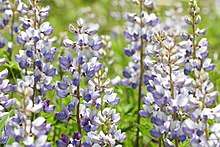Lupinus perennis
| Lupinus perennis | |
|---|---|
 | |
| Scientific classification | |
| Kingdom: | Plantae |
| Clade: | Angiosperms |
| Clade: | Eudicots |
| Clade: | Rosids |
| Order: | Fabales |
| Family: | Fabaceae |
| Genus: | Lupinus |
| Subgenus: | Lupinus subg. Platycarpos |
| Species: | L. perennis |
| Binomial name | |
| Lupinus perennis | |
Lupinus perennis (also wild perennial lupine, wild lupine,[2] sundial lupine, blue lupine, Indian beet, or old maid's bonnets) is a flowering plant in the Fabaceae family. It is widespread in the eastern part of the USA (from Texas and Florida to Maine) and Minnesota, Canada (southern Ontario, Newfoundland and Labrador), and on the coasts of the Arctic Ocean, where it grows in sandy areas such as dunes and savannas.[3][4]
Description
The leaves are palmately compound with 7–11 leaflets arranged radially. Their stalks are numerous, erect, striated, and slightly pubescent. The leaflets are obovate, with a blunted apex or pointed spear, and sparsely pubescent.[2] Petioles are longer than leaflets; stipules are very small.
The inflorescence is long, sparsely flowered, sometimes almost verticilate. Flowers color can be white, blue, purple, or pink, but are most often blue or bluish purple. The calyx is silky, without bractlets; its upper labium with a protuberant basis, is integral or weakly emarginate, the lower one is integral, almost twice longer than upper. Floral bracts are styliform, shorter than the calyx, early falling. The corolla is three times longer than the calyx. The vexillum is shorter than the wings. The carina is weakly ciliate. Pods are yellow-grayish-brown, with straight lines, necklace-shaped, short and closely hirsute, easy shattered, with 5–6 seeds. Seed is oval with a light hilum.
Ecology

Lupinus perennis is used as foodplants by the caterpillars of several lepidoptera. Among these are the frosted elfin (Callophrys irus), the eastern Persius duskywing (Erynnis persius persius),[5] and the rare and endangered Karner blue (Lycaeides melissa samuelis), whose caterpillars feed only on the lupine leaves. Leaves that have been fed on by Karner blues have distinctive transparent areas where the larvae have selectively eaten only the green, fleshy parts.
The lupine has been declining in number and range since the Industrial Revolution. It is estimated that it has declined in number by about 90% since 1900. This decline has been deemed one of the primary causes of the Karner blues' endangerment. The main causes of its decline are thought to be habitat loss, habitat fragmentation, and poor management. Currently it is threatened in Iowa, Maryland, and New Hampshire; it is endangered in Vermont, and is extirpated in Maine. Human development has eliminated a large portion of its viable habitat. Remaining habitat is often fragmented, which is problematic for the lupine because it limits the range over which it can reproduce. Viable lupine habitat is often difficult to maintain because it flourishes after fires and other forms of disturbance. One reason this occurs is that lupine seed coats are so tough that only pressure changes due to rapid heating or abrasion are strong enough to allow water to penetrate and start germination. Moreover, fires, feeding by large ungulates, and mowing can improve habitat quality for established lupines by changing soil quality, vegetative structure, and leaf litter depth.
References
- ↑ "Lupinus perennis L." ipni.org. International Plant Names Index. Retrieved 2018-09-23.
- 1 2 Dickinson, T.; Metsger, D.; Bull, J.; & Dickinson, R. (2004). The ROM Field Guide to Wildflowers of Ontario. Toronto:Royal Ontario Museum, p. 270.
- ↑ Biota of North America Program, 2013 county distribution map
- ↑ Hilty, John. "Wild Lupine (Lupinus perennis)". illinoiswildflowers.info. Retrieved 2018-09-23.
- ↑ Eastern Persius duskywing, Species at Risk in Ontario
External links
| Wikimedia Commons has media related to Lupinus perennis. |